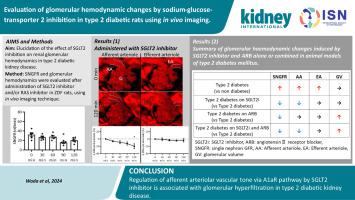当前位置:
X-MOL 学术
›
Kidney Int.
›
论文详情
Our official English website, www.x-mol.net, welcomes your feedback! (Note: you will need to create a separate account there.)
Evaluation of glomerular hemodynamic changes by sodium-glucose-transporter 2 inhibition in type 2 diabetic rats using in vivo imaging
Kidney International ( IF 14.8 ) Pub Date : 2024-05-25 , DOI: 10.1016/j.kint.2024.05.006 Yoshihisa Wada , Kengo Kidokoro , Megumi Kondo , Atsuyuki Tokuyama , Hiroyuki Kadoya , Hajime Nagasu , Eiichiro Kanda , Tamaki Sasaki , David Z.I. Cherney , Naoki Kashihara
Kidney International ( IF 14.8 ) Pub Date : 2024-05-25 , DOI: 10.1016/j.kint.2024.05.006 Yoshihisa Wada , Kengo Kidokoro , Megumi Kondo , Atsuyuki Tokuyama , Hiroyuki Kadoya , Hajime Nagasu , Eiichiro Kanda , Tamaki Sasaki , David Z.I. Cherney , Naoki Kashihara

|
The mechanisms responsible for glomerular hemodynamic regulation with sodium-glucose co-transporter 2 (SGLT2) inhibitors in kidney disease due to type 2 diabetes remain unclear. Therefore, we investigated changes in glomerular hemodynamic function using an animal model of type 2 diabetes, treated with an SGLT2 inhibitor alone or in combination with a renin-angiotensin-aldosterone system inhibitor using male Zucker lean (ZL) and Zucker diabetic fatty (ZDF) rats. Afferent and efferent arteriolar diameter and single-nephron glomerular filtration rate (SNGFR) were evaluated in ZDF rats measured at 0, 30, 60, 90, or 120 minutes after the administration of a SGLT2 inhibitor (luseogliflozin). Additionally, we assessed these changes under the administration of the adenosine A1 receptor (A1aR) antagonist (8-cyclopentyl-1,3-dipropylxanthine), along with coadministration of luseogliflozin and an angiotensin II receptor blocker (ARB), telmisartan. ZDF rats had significantly increased SNGFR, and afferent and efferent arteriolar diameters compared to ZL rats, indicating glomerular hyperfiltration. Administration of luseogliflozin significantly reduced afferent vasodilatation and glomerular hyperfiltration, with no impact on efferent arteriolar diameter. Urinary adenosine levels were increased significantly in the SGLT2 inhibitor group compared to the vehicle group. A1aR antagonism blocked the effect of luseogliflozin on kidney function. Co-administration of the SGLT2 inhibitor and ARB decreased the abnormal expansion of glomerular afferent arterioles, whereas the efferent arteriolar diameter was not affected. Thus, regulation of afferent arteriolar vascular tone via the A1aR pathway is associated with glomerular hyperfiltration in type 2 diabetic kidney disease.
中文翻译:

使用体内成像评估 2 型糖尿病大鼠钠葡萄糖转运蛋白 2 抑制引起的肾小球血流动力学变化
钠-葡萄糖协同转运蛋白 2 (SGLT2) 抑制剂在 2 型糖尿病引起的肾脏疾病中调节肾小球血流动力学的机制尚不清楚。因此,我们使用 2 型糖尿病动物模型研究了肾小球血流动力学功能的变化,该模型单独接受 SGLT2 抑制剂治疗,或与肾素-血管紧张素-醛固酮系统抑制剂联合治疗,使用雄性 Zucker 瘦肉 (ZL) 和 Zucker 糖尿病脂肪 (ZDF)老鼠。在给予 SGLT2 抑制剂(luseogliflozin)后 0、30、60、90 或 120 分钟测量 ZDF 大鼠的传入和传出小动脉直径以及单肾单位肾小球滤过率 (SNGFR)。此外,我们还评估了使用腺苷 A1 受体 (A1aR) 拮抗剂(8-环戊基-1,3-二丙基黄嘌呤)以及联合使用卢塞格列净和血管紧张素 II 受体阻滞剂 (ARB) 替米沙坦时的这些变化。与 ZL 大鼠相比,ZDF 大鼠的 SNGFR 以及传入和传出小动脉直径显着增加,表明肾小球过度滤过。给予卢塞奥格列净可显着减少传入血管舒张和肾小球过度滤过,但对传出小动脉直径没有影响。与媒介物组相比,SGLT2抑制剂组的尿腺苷水平显着增加。 A1aR 拮抗作用阻断了 luseogliflozin 对肾功能的影响。 SGLT2抑制剂和ARB的共同给药减少了肾小球传入小动脉的异常扩张,而传出小动脉直径不受影响。因此,通过 A1aR 途径调节传入小动脉血管张力与 2 型糖尿病肾病中的肾小球高滤过相关。
更新日期:2024-05-25
中文翻译:

使用体内成像评估 2 型糖尿病大鼠钠葡萄糖转运蛋白 2 抑制引起的肾小球血流动力学变化
钠-葡萄糖协同转运蛋白 2 (SGLT2) 抑制剂在 2 型糖尿病引起的肾脏疾病中调节肾小球血流动力学的机制尚不清楚。因此,我们使用 2 型糖尿病动物模型研究了肾小球血流动力学功能的变化,该模型单独接受 SGLT2 抑制剂治疗,或与肾素-血管紧张素-醛固酮系统抑制剂联合治疗,使用雄性 Zucker 瘦肉 (ZL) 和 Zucker 糖尿病脂肪 (ZDF)老鼠。在给予 SGLT2 抑制剂(luseogliflozin)后 0、30、60、90 或 120 分钟测量 ZDF 大鼠的传入和传出小动脉直径以及单肾单位肾小球滤过率 (SNGFR)。此外,我们还评估了使用腺苷 A1 受体 (A1aR) 拮抗剂(8-环戊基-1,3-二丙基黄嘌呤)以及联合使用卢塞格列净和血管紧张素 II 受体阻滞剂 (ARB) 替米沙坦时的这些变化。与 ZL 大鼠相比,ZDF 大鼠的 SNGFR 以及传入和传出小动脉直径显着增加,表明肾小球过度滤过。给予卢塞奥格列净可显着减少传入血管舒张和肾小球过度滤过,但对传出小动脉直径没有影响。与媒介物组相比,SGLT2抑制剂组的尿腺苷水平显着增加。 A1aR 拮抗作用阻断了 luseogliflozin 对肾功能的影响。 SGLT2抑制剂和ARB的共同给药减少了肾小球传入小动脉的异常扩张,而传出小动脉直径不受影响。因此,通过 A1aR 途径调节传入小动脉血管张力与 2 型糖尿病肾病中的肾小球高滤过相关。











































 京公网安备 11010802027423号
京公网安备 11010802027423号